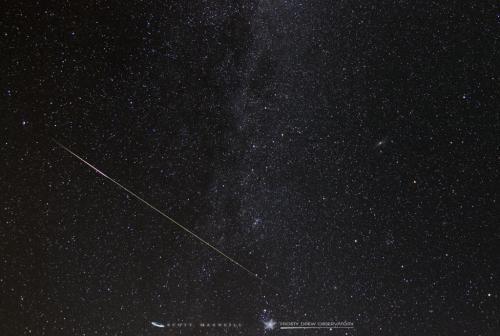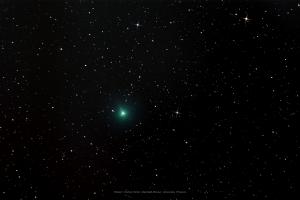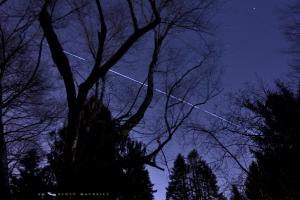Celebration of Space - April 17, 2020
This coming Wednesday morning, April 22, 2020 the annual Lyrid Meteor Shower will peak. Bringing with it an increase in regular meteor activity by about 18 meteors per hour, the Lyrids are not very active. Though this shower ends the long 3.5 month lull in meteor activity. The Lyrids get their name from the spot in the sky that meteors appear to radiate from (radiant point), the constellation Lyra, specifically about 8° west of the bright star Vega. Though in modern times, this is not actually the constellation Lyra, but the constellation Hercules. Meteor shower naming predates the International Astronomy Union’s (IAU) establishment of official constellation boundaries, so the shower retains its name. Best times to observe the Lyrids (or any meteor shower for that matter) is when the radiant point of the shower is well above the horizon, while the Moon is not out. The higher the radiant point is in the sky, the more meteors you will spot. At midnight, the radiant point will be about 34° over the eastern horizon, making best times to observe during the morning hours until pre-dawn. Considering the 1% waning crescent Moon rises with the Sun, viewing conditions are excellent! All we need now is a clear sky. To observe, set out to a dark location largely free of artificial light after midnight, lay on your back so you are looking to the zenith (top of the sky) with your feet pointed south. I know this may be a bit difficult with many parks closed, though dark spots are out there (parking lot at Point Judith?)! Meteors will be visible as very fast streaks of light across the sky (shooting stars). The best thing about the Lyrid shower is that during the morning hours the Milky Way galactic nucleus will rise quite high in the sky, with the Milky Way galaxy stretching across the sky nearly overhead. This will give you an opportunity to catch a beautiful sight of the Milky Way during the best viewing season! So put the 22nd on your calendar and set out with your family for a beautiful early morning under the stars.
Last week during our live stream we talked a bit about Comet Y4 Altas as well as showed recent captures of the comet. We mentioned the possibility that the comet may be breaking up, and if so, that it would ruin the prospects of awesome comet viewing over the next couple of months. Well recent images of Comet Atlas are showing exactly that. The comet appears to have fractured into two separate nuclei that are quite unstable. Over the last couple of days the comet has dimmed by a factor of 6.25, which does not bode well for upcoming views of the comet as it reaches perihelion (closest to the Sun) on May 31, 2020. Actually, it appears that the comet has potentially expended all of its gas and dust and will likely not survive its encounter with the solar wind before reaching perihelion. Regardless, the view was nice while it lasted.
Fret not! Though Comet Atlas appears to be falling apart, there is a new comet that was discovered just this past week, a comet that has already become quite bright and may become naked eye visible within the next month. The comet is C/2020 F8 SWAN (Comet SWAN), and is currently visible from the Southern Hemisphere. Though it will become visible to Northern Hemisphere sky watchers next month low in the eastern sky before dawn. Comet SWAN will reach perihelion on May 27, 2020. The reason Comet SWAN has grown so brightly is likely because the comet is experiencing an outburst, which happens when the nucleus fractures. So like Comet Atlas, this new comet may not survive its passage around the Sun and could break up before it becomes naked eye visible. Until then, let’s hope that Comet SWAN becomes the rebound comet after the potentially untimely demise of Comet Atlas. We will post additional updates about Comet SWAN as they become available.
Starting tonight, April 17, 2020 and continuing nightly until May 10, 2020, the SpaceX Starlink satellites from launch 5 will be visible in the evening hours. Though it’s been about a month since the launch, so satellites will be quite dim. Observing the Starlink satellites pass is quite interesting as they all are equally spaced out in the sky, moving in the same direction with the same trajectory. Aside from the ranting, hype, and freak-outs about the Starlink constellation satellites, which we won’t go into here, the view should be impressive. Visit Heavens Above, where you can get Starlink pass times for the launch 5 satellites. Check out the page every day and put the start time of the first satellite on your calendar or alarm, then sit out and watch the constellation pass like a procession of stars moving across the sky!
We miss you all and hope to see you all soon!
-Scott
- Author:
- Scott MacNeill
- Entry Date:
- Apr 17, 2020
- Published Under:
- Scott MacNeill's Columns




